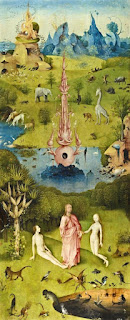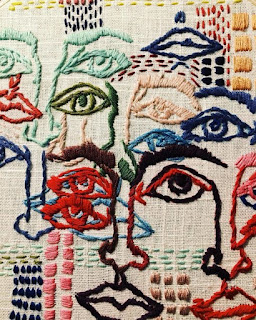In this blog post i'm going to develop deeply the symbolism of the painting "Garden of earthly delights" to help me in my creative thinking while i am making my final project.
This painting is one of the most complex and enigmatic creations.
The three scenes were painted with a common concept of sin, as we look, starts in paradise with Adam and Eve and ends in hell. The middle panel, representing the earth with influence of medieval symbolism, give an idea of false paradise and given over to the sin of lust.
he dominant subject of the painting is fleshy pleasure.
fleeting nature of pleasure
it depicts the union of Adam and Eve on the left panel, the aforementioned bacchanal on the sprawling central panel, and a bawdy Hell on a panel to the right. Taken as a single narrative, it shows the fiery fate of humanity consumed by passion and pleasure.
The central panel is the painting’s largest and shows a pleasure garden bursting with mostly nude, beautiful young things engaging in all manner of amorous acrobatics.
Surrounding the figures we see spurting fountains, fecund fruit trees, and a vast array of creatures that allude to the pleasures and chaos to come.
The animals that cover the central panel also evoke carnal urges.
“If we look closely, the only thing that connects Paradise with Hell is sin.” cited by Pilar Silva Maroto, curator at the Museo del Prado
The final panel depicts a dusky, humorously bizarre hellscape.
A lot of details are gorier.
the power of Bosch’s work lies not only in its innovative, curiosity-sparking symbolism, but in its ability to harness timeless human urges and reflect them back into contemporary viewer’s worlds with mesmerizing relevancy.
Source
Alexxa Gotthardt in Decoding Bosch’s Wild, Whimsical “Garden of Earthly Delights”. [online] available at https://www.artsy.net/series/stories-10-art-historys-iconic-works/artsy-editorial-decoding-boschs-wild-whimsical-garden-earthly-delights




















